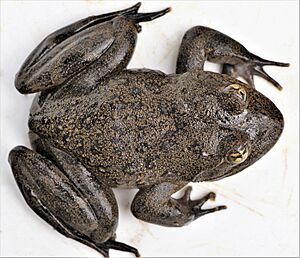Maluti river frog facts for kids
Quick facts for kids Maluti river frog |
|
|---|---|
 |
|
| Conservation status | |
| Scientific classification | |
| Synonyms | |
|
The Maluti River Frog (also called Amietia vertebralis) is a special type of frog. People also know it as the ice frog or water frog. It belongs to the Pyxicephalidae family of frogs. This amazing frog lives mostly in water, high up in the mountains. You can find it in Lesotho and nearby parts of South Africa.
Contents
What Does It Look Like?
The Maluti River Frog is dark brown and has very bumpy, warty skin. It looks a bit squat or flattened. This frog is quite large. From its nose to its rear end, it can be about 150 millimetres (6 in) long. If you measure from its nose to the tip of its longest toe, it can reach 360 millimetres (14 in). Female frogs are usually bigger than males.
Its head can be about 57 millimetres (2+1⁄4 in) wide. The frog's belly and the inside of its legs are white. They have a dark, net-like pattern. Its toes have a lot of webbing, which helps it swim.
Tadpoles
The baby frogs, called tadpoles, are big and strong. A tadpole at a certain stage (called Gosner stage 40) can be about 71 mm (2.8 in) long. Their bodies, tails, and fins are covered in dark spots.
Where Does It Live and How Does It Survive?
The Maluti River Frog lives in cold, clear mountain streams. These streams are found in grassy areas high up in the mountains. It lives at elevations from 1,600–3,400 m (5,200–11,200 ft) above sea level. This frog depends a lot on water and spends most of its time there.
It can stay underwater for a very long time, sometimes up to 30 hours! In winter, you might even see it swimming under ice. However, sometimes tadpoles can get stuck in the ice.
Reproduction and Life Cycle
Maluti River Frogs breed when the weather is warmer. Male frogs call out to attract females while they are underwater or with just their heads sticking out. The female lays many eggs in large groups. These egg groups stick to plants that are underwater.
Young tadpoles and juvenile frogs spend more time near the water's surface. They also prefer shallower pools than adult frogs.
What Does It Eat?
A big part of the Maluti River Frog's diet is Freshwater crabs.
Protecting the Maluti River Frog
This frog is quite common in its local areas. It usually lives in very clean, untouched places. However, it can sometimes be found in polluted spots too.
Some things can threaten these frogs. These include planting too many trees (afforestation) and building dams. Too much overgrazing by animals can also harm their rivers. This causes dirt and mud (silt) to build up in the water.
Other possible dangers include a frog disease called chytridiomycosis. Fish like trout, which are not native to the area, can also be a problem. People sometimes use this frog in traditional medicine for burns. But this use is probably not a big threat to the frog population.
The good news is that the Maluti River Frog lives in several protected areas. These are in both Lesotho and South Africa.


